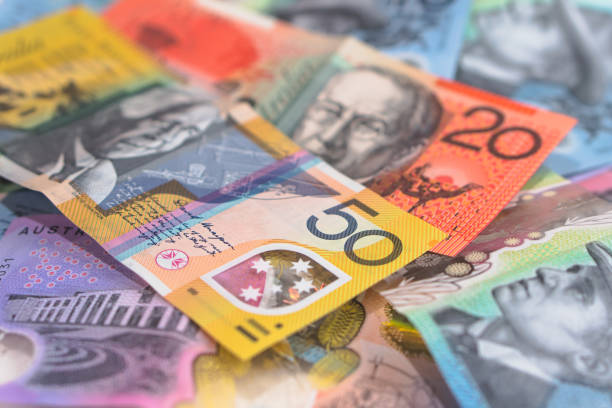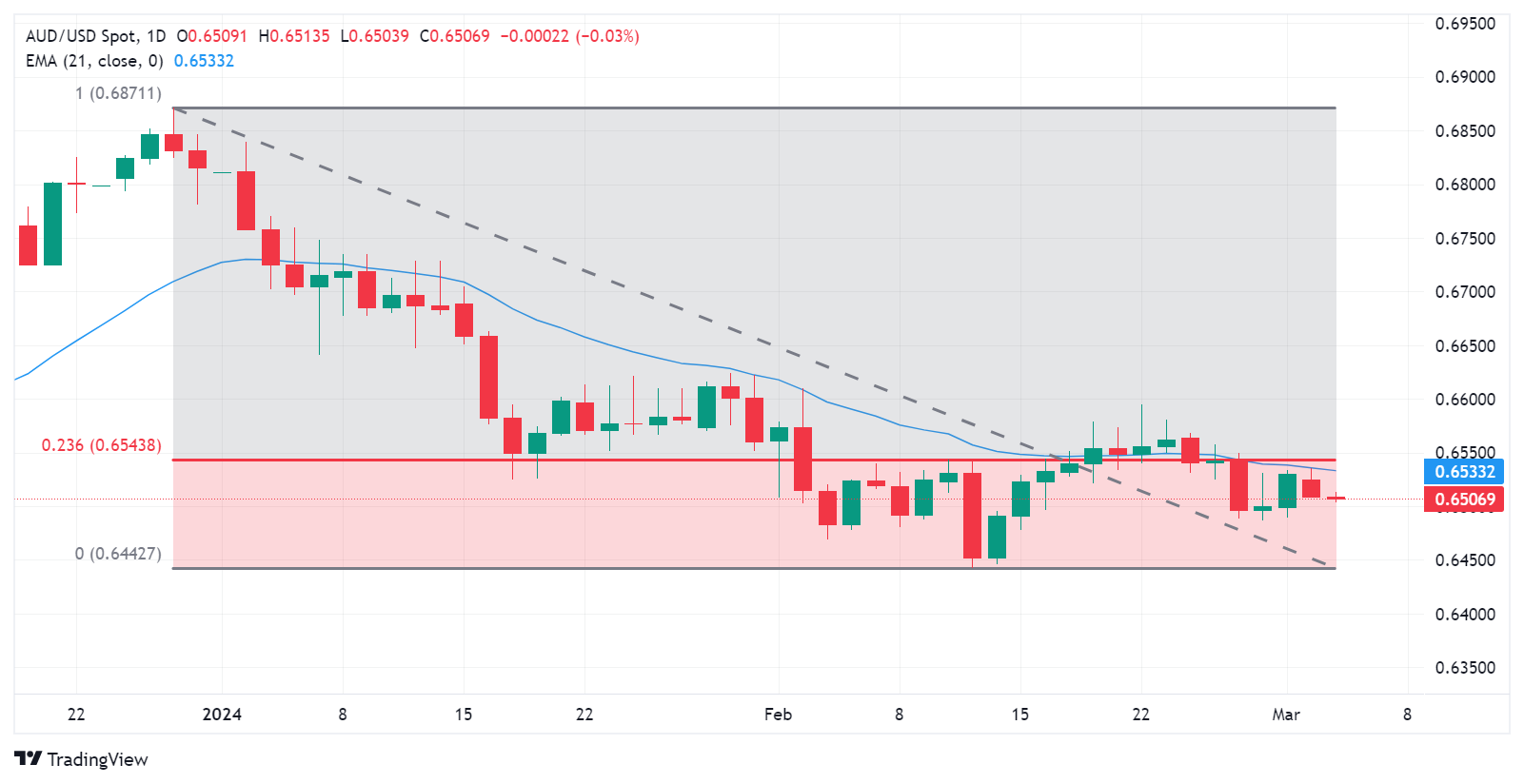
■ Australian Dollar remains tepid, possibly influenced by a risk-off sentiment.
■ Australian Services PMI rose to a ten-month high of 53.1 in February, against 49.1 prior.
■ China aims for 5% GDP growth in 2024 by creating jobs and defusing risks.
■ US Dollar maintains stability despite lower US Treasury yields.
The Australian Dollar (AUD) consolidates with a negative bias on Tuesday after experiencing losses in the previous session, possibly due to prevailing risk-off sentiment amid a stagnant ASX 200 Index. Additionally, China aims for approximately 5% GDP growth in 2024 by focusing on job creation and risk mitigation. Chinese authorities emphasize the importance of continuing proactive fiscal policies and prudent monetary measures.
Australian Dollar remains unaffected by the positive performance of the Judo Bank Services Purchasing Managers Index (PMI), which surged to a ten-month high of 53.1 in February. This increase pushed the index above the 50.0 threshold, indicating expansion, and surpassed the previous reading of 49.1. Additionally, the Composite PMI rose to 52.1 compared to the previous 49.0, marking a nine-month high. Traders are now awaiting the release of the Gross Domestic Product (GDP) data for the fourth quarter of 2023 on Wednesday.
The US Dollar Index (DXY) remains relatively unchanged, displaying a sideways movement amid subdued US Treasury yields. Market participants are closely eyeing crucial United States (US) employment figures scheduled for release this week as they assess the Federal Reserve's (Fed) potential future actions. Fed Chairman Jerome Powell is set to testify before the US Congress' House Financial Services Committee regarding the Fed's Semi-Annual Monetary Policy Report on both Wednesday and Thursday, which could provide further insights into the central bank's stance and upcoming policy decisions.
Daily Digest Market Movers: Australian Dollar consolidates amid a flat equity market
Australian Current Account Balance rose to 11.8 billion in the fourth quarter of 2023, against the expected 5.6 billion and 1.3 billion prior.
ANZ-Roy Morgan Australian Consumer Confidence index declined to 81.0, from the previous reading of 83.2. This latest figure represents the lowest level recorded thus far in 2024.
Australia Melbourne Institute Inflation for February showed a year-over-year rise of 4.0%, lower than the previous rise of 4.6%.
Australian Building Permits (MoM) declined by 1.0% in January, contrary to the expected rise of 4.0%. Nevertheless, this figure represented an improvement from the previous decrease of 10.1%.
Australia’s TD Securities Inflation (MoM) decreased by 0.1% in February, lower than the previous rise of 0.3%.
Australian Bureau of Statistics released Company Gross Operating Profits (QoQ), rising by 7.4% in the fourth quarter of 2023 against the expected 1.8% increase and the previous decrease of 1.6%.
Australian Building Permits (YoY) rose by 10% in January, swinging from the previous decline of 24%.
Judo Bank Manufacturing PMI indicated a slight improvement in Australia's manufacturing sector, with the February reading rising to 47.8 from 47.7 in the previous period.
The seasonally adjusted Australian Retail Sales (MoM) grew by 1.1% in January, lower than expected 1.5% but swinging from the previous decline of 2.7%.
Australian Private Capital Expenditure improved by 0.8% in the fourth quarter of 2023, from the expected 0.5% and 0.6% prior.
According to Matthew De Pasquale, an Economist at Judo Bank, the February Services PMI suggests that the sector has achieved a soft landing in 2023 and is now witnessing a resurgence in activity in early 2024. While the resilience in business activity bodes well for economic growth and employment, it casts doubt on the likelihood of inflation returning to target within the Reserve Bank of Australia's forecast timeline.
China's National People's Congress (NPC) spokesman Lou Qinjian shared with the news media that Congress will hold its annual meeting in Beijing from March 5 to March 11. Lou stated that the government “will make new laws to deepen economic reform including financial institutional reform to promote private companies.” Moreover, the Premier of the People's Republic of China (PBoC), Li Qiang is expected to reveal China's economic growth target of around 5% at the session on Tuesday.
Atlanta Federal Reserve (Fed) President Raphael Bostic made headlines on Monday, expressing uncertainty about achieving a soft landing. He does not foresee consecutive rate cuts when they commence but still expects two 25-basis point rate cuts in 2024. While inflation is expected to return to the 2% target, Bostic believes it is premature to declare victory.
According to the CME FedWatch Tool, there is a 3.0% probability of a 25 basis points rate cut in March, while the likelihood of cuts in May and June stands at 21.8% and 50.9%, respectively.
US ISM Manufacturing PMI (Feb) dropped to 47.8 from 49.1, surprisingly missing the market expectation 49.5.
The US Michigan Consumer Sentiment Index declined to 76.9 in February, falling below the market expectation of remaining unchanged at 79.6.
US Personal Consumption Expenditure (PCE) Price Index grew by 2.4% YoY in January, against the 2.6% prior, in line with the market expectation. The index increased by 0.3% month-over-month, against 0.1% prior.
Technical Analysis: Australian Dollar hovers above the psychological level of 0.6500
The Australian Dollar is trading around 0.6510 on Tuesday. Immediate resistance is noted near the 21-day Exponential Moving Average (EMA) at 0.6533, followed by the 23.6% Fibonacci retracement level at 0.6543 and the major level of 0.6550. A break above this resistance zone could lead the pair towards the psychological level of 0.6600.
On the downside, key support is seen at the psychological level of 0.6500, followed by the previous week’s low at 0.6486. If breached, the pair may target the area around the major support level of 0.6450 and February’s low at 0.6442.
AUD/USD: Daily Chart

* The content presented above, whether from a third party or not, is considered as general advice only. This article should not be construed as containing investment advice, investment recommendations, an offer of or solicitation for any transactions in financial instruments.




